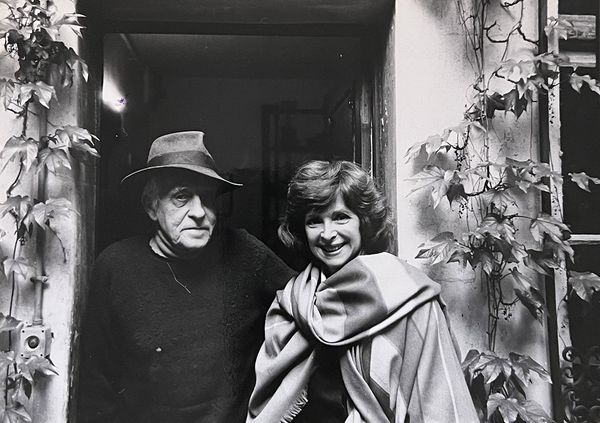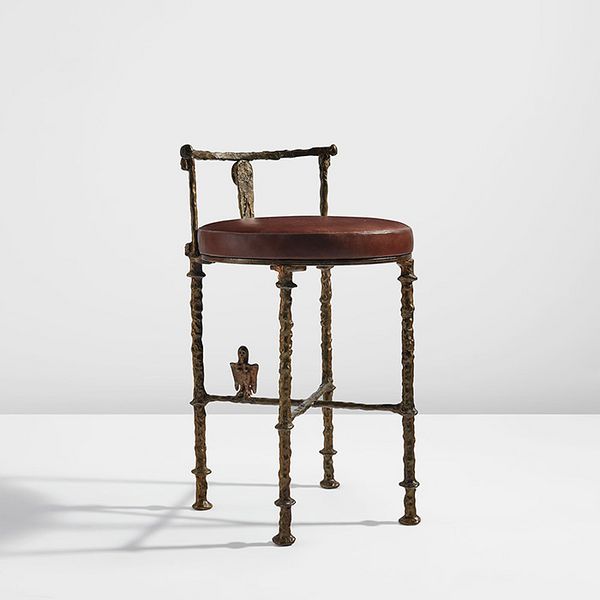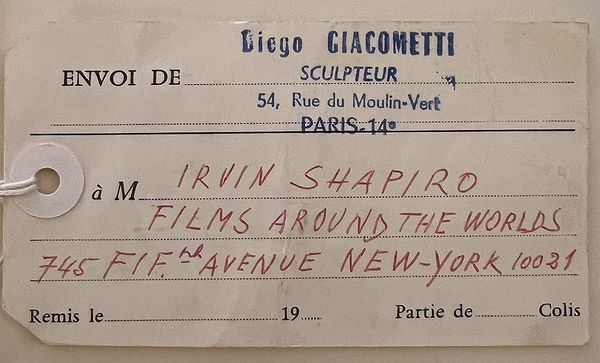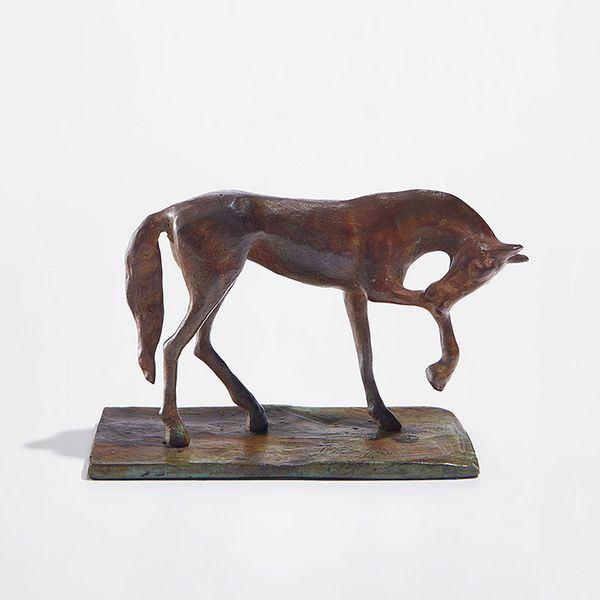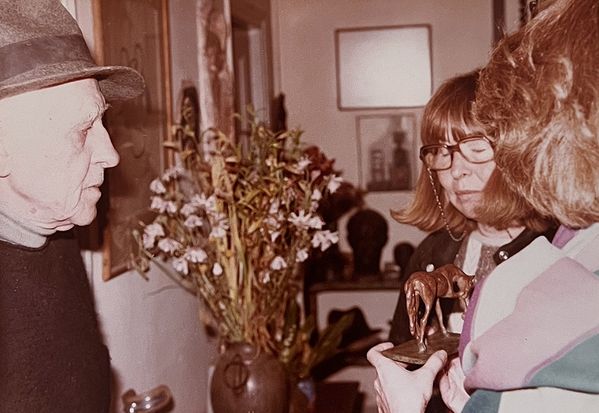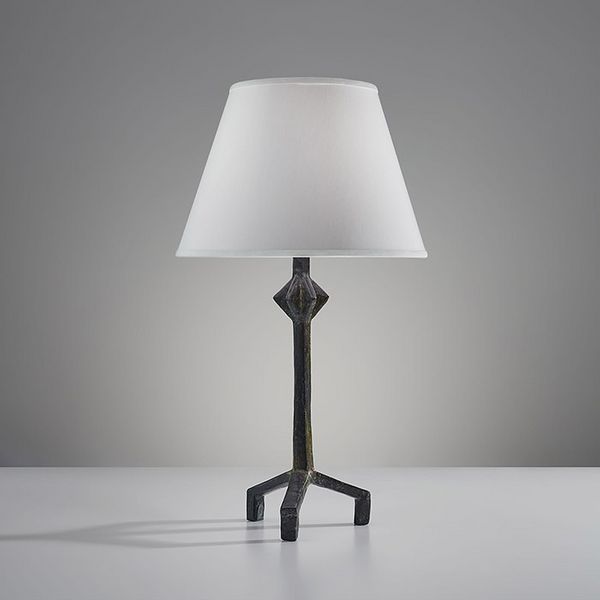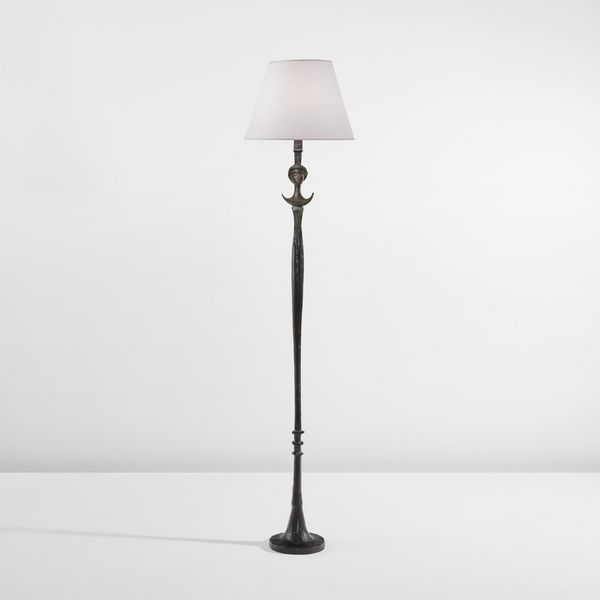Diego Giacometti and Diana F. Shapiro at the artist’s studio, 1984.
The timeless furniture and objects that Diego Giacometti modestly referred to as his “things” were always made for someone in particular. While he counted Hubert de Givenchy, Bunny Mellon, and Cecil Beaton among his more illustrious patrons, the group on offer in the June 5 Phillips Design sale, from the estate of Diana F. Shapiro, stands as a testament to a lesser-known friendship that endured for nearly twenty years.
Diego Giacometti, Tabouret à la harpie. New York Design.
Exactly how Diana F. Shapiro met Diego Giacometti remains unknown, but her husband, Irvin Shapiro, may have crossed paths with the artist through his work as a producer and distributor of foreign films. His company, Films Around the World, introduced American audiences to the work of French filmmakers such as Jean Renoir and Jean-Luc Godard. Diana maintained diligent records and in a file with newspaper clippings and photographs with Diego, she kept receipts that attest that the artist sold the Figure floor lamp, Étoile table lamp, and Berceau low table to Irvin Shapiro in 1969. In keeping with Diego’s earlier furniture production, the table is unsigned, as are the two lamps which his brother Alberto Giacometti designed in the 1930s and which Diego later cast. A little over a decade later, in 1977, Diana commissioned the Tabouret à la harpie from Diego. For this design, Diego typically adorned one of the bottom stretchers with a little mouse, but Diana opted for the mythical harpie perched on her version, telling friends that the mouse would have been too startling to live with. Finally, in 1984, just a year before he passed away, Diego gifted Diana a cast of his charming sculpture of a horse, Cheval, tête baissée.
Label from Diego Giacometti to Irvin Shapiro, circa 1969.
Diego Giacometti was in his late 60s when Diana and Irvin Shapiro acquired their first pieces from him. Alberto had passed away just three years prior and it was at this time that Diego turned his full attention to furniture making, although he had already spent decades working with the same materials as Alberto’s assistant. Raised in the Val Bregaglia, an alpine valley of Switzerland and Italy, Diego joined his brother Alberto in Paris in 1925. While Alberto forged his way as an artist in the Surrealist movement of the 1920s and 30s, the two brothers also collaborated on creating furniture and lighting for the interior designer Jean-Michel Frank. Following the war, they resumed working together, with Diego assisting with the armatures for Alberto’s sculptures, as well as overseeing the casting and patination of his work in bronze.
Diego Giacometti, “Berceau” low table, second version. New York Design.
The perfect proportions of Diego’s furniture reflect his deep respect for craft and the skills he honed over the many years he spent working alongside his brother. The Berceau low table, for example, though solid and strong in cast bronze, stands with erect posture and tension like a tightly strung bow, a feat which required a deep knowledge of the possibilities and limits of casting in bronze. The uneven surface texture of the bronze, created by building up the maquette with layers of plaster over a wire or steel armature, may recall the working process of Alberto, but Diego also had his own distinct voice as an artist. While Alberto plumbed the darkest depths of humanity with his bronze busts and Walking Men, Diego brought humor, whimsy, and a love of animals to his creations, as evidenced by the charismatic Cheval with its gently tucked head, part of Diego’s larger bestiary in bronze that included cats, dogs, birds, foxes, lions, toads, and mice.
Diego Giacometti, Cheval, tête baissée. New York Design.
Diego maintained the same studio since the pre-war period. Working on a very small scale of production, he had his creations rough-cast outside Paris and then completed the finishing work, including filing and patination, in the courtyard outside his home in the rue du Moulin Vert in Montparnasse. By the time Diana acquired her last piece in 1984, he was busy on his final major commission, creating the furniture and lighting for the Musée Picasso which opened shortly after his death in 1985. Diego had known Picasso and his timeless furnishings offered the perfect through line to connect the building’s seventeenth-century architecture with Picasso’s modernist masterpieces.
Diana F. Shapiro receiving Le Cheval, tête baissée from Diego Giacometti, 1984. Artwork: © 2024 Artists Rights Society (ARS), New York / ADAGP, Paris. Image courtesy: the Estate of Diana Shapiro.
Indeed, by the 1980s, Diego himself had become something of a portal to an earlier time. As noted in his New York Times obituary, “…for the people who flocked to his studio in the 14th Arrondissement in Paris during the last 20 years, Diego's importance went beyond this. Not only had he known Miro, Braque, Matisse, Ernst and Picasso, but his own life was itself a link to another age. Diego was almost untouched by technology. Throughout his success he remained in the same tiny studio, filled with dusty shelves, old tools, coats of plaster and adopted stray cats…With his house wedged in by highrises, he became increasingly the embodiment of an older rural Europe that has largely vanished from contemporary European urban life.”
Alberto Giacometti, "Étoile" table lamp. New York Design.
In a similar vein, the five works acquired by Diana F. Shapiro over a decades-long friendship with Diego Giacometti, and then cherished and kept in the same New York City apartment for decades longer, offer a window into a past time and remain a testament to a beautiful friendship built on a legacy and love of art.
Alberto Giacometti, "Figure" floor lamp. New York Design.
Recommended Reading
Dancer in the Dark: Voulkos's Rasgeado >
Beyond Face Value: The Ear Sofa and Nose Sconces by John Baldessari >
